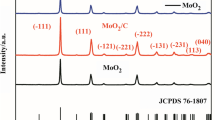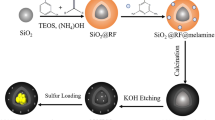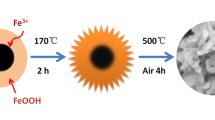Abstract
To explore high-performance carbon anodes for potassium-ion batteries, monodisperse novel hollow carbon spheres (MHCSs) were synthesized via a combination of hydrothermal reactions and high-temperature pyrolysis using 2,4-dihydroxybenzoic acid and hexamethylenetetramine as the main raw materials. The synthesized MHCSs range from 140 to 260 nm in size with a large specific area of 466 m2 g-1. The potassium storage performance and dynamics of MHCSs in KN(SO2F)2 (KFSI) and KPF6 electrolytes were systematically investigated. In the KFSI electrolyte, the MHCSs have a higher reversible capacity, better cycling stability, better rate performance, and faster electrode process dynamics than in the KPF6 electrolyte. The excellent electrochemical performance of MHCSs in the KFSI electrolyte is attributed to the hollow structure of the material and the formation of a KF-rich and uniform solid-electrolyte interface film.





Similar content being viewed by others
Data availability
All data generated and analyzed during this study are included in this published article and its supplementary information files.
References
Zhang W, Liu Y, Guo Z (2019) Approaching high-performance potassium-ion batteries via advanced design strategies and engineering. Sci Adv 5(5):eaav7412 https://doi.org/10.1126/sciadv.aav7412
Cheng G, Zhang W, Wang W, Wang H, Wang Y, Shi J, Chen J, Liu S, Huang M, Mitlin D (2022) Sulfur and nitrogen codoped cyanoethyl cellulose-derived carbon with superior gravimetric and volumetric capacity for potassium ion storage. Carbon Energy 4(5):986–1001. https://doi.org/10.1002/cey2.233
Wu Y, Wu P, Tang Y, Fu R, Cui Y, Chen J, Kübel C, Xu F (2023) Deciphering unexplored reversible potassium storage and small volume change in a CaV4O9 anode with in situ transmission electron microscopy. Adv Funct Mater: 2314344. https://doi.org/10.1002/adfm.202314344
Feng W, Wei X, Cao F, Li Y, Zhang X, Li Y, Liu W, Han J, Kong D, Zhi L (2024) Defective MoSSe with local-expanded structure for high-rate potassium ion battery. Energy Stor Mater 65:103186. https://doi.org/10.1016/j.ensm.2024.103186
Guan S, Zhou J, Sun S, Peng Q, Guo X, Liu B, Zhou X, Tang Y. (2024). Nonmetallic Se/N Co‐doped amorphous carbon anode collaborates to realize ultra‐high capacity and fast potassium storage for potassium dual‐ion batteries. Adv Funct Mater: 2314890. https://doi.org/10.1002/adfm.202314890
Cai Y, Liu W, Chang F, Jin S, Yang X, Zhang C, Bai L, Masese T, Li Z, Huang Z (2023) Entropy-stabilized layered K0.6Ni0.05Fe0.05Mg0.05Ti0.05Mn0.725O2 as a high-rate and stable cathode for potassium-ion batteries. ACS Appl Mater Interfaces 15(41):48277-48286 https://doi.org/10.1021/acsami.3c11059
Dong S, Li Z, Xing Z, Wu X, Ji X, Zhang X (2018) Novel potassium-ion hybrid capacitor based on an anode of K2Ti6O13 microscaffolds. ACS Appl Mater Interfaces 10(18):15542–15547. https://doi.org/10.1021/acsami.7b15314
Sabaghi D, Polčák J, Yang H, Li X, Morag A, Li D, Nia AS, Khosravi HS, Šikola T, Feng X, Yu M (2024) Multifunctional molecule-grafted V2C MXene as high-kinetics potassium-ion-intercalation anodes for dual-ion energy storage devices. Adv Energy Mater 14(3):202302961. https://doi.org/10.1002/aenm.202302961
Ming J, Cao Z, Wahyudi W, Li M, Kumar P, Wu Y, Hwang J, Hedhili MN, Cavallo L, Sun Y, Li L (2018) New insights on graphite anode stability in rechargeable batteries: Li Ion coordination structures prevail over solid electrolyte interphases. ACS Energy Lett 3(2):335–340. https://doi.org/10.1021/acsenergylett.7b01177
Liu G, Cao Z, Zhou L, Zhang J, Sun Q, Hwang JY, Cavallo L, Wang L, Sun YK, Ming J (2020) Additives engineered nonflammable electrolyte for safer potassium ion batteries. Adv Funct Mater 30(43):2001934. https://doi.org/10.1002/adfm.202001934
Zhang J, Cao Z, Zhou L, Liu G, Park G, Cavallo L, Wang L, Alshareef HN, Sun Y, Ming J (2020) Model-based design of graphite-compatible electrolytes in potassium-ion batteries. ACS Energy Lett 5(8):2651–2661. https://doi.org/10.1021/acsenergylett.0c01401
Xiao B, Zhang H, Sun Z, Li M, Fan Y, Lin H, Liu H, Jiang B, Shen Y, Wang M, Li M, Zhang Q (2023) Achieving high-capacity and long-life K+ storage enabled by constructing yolk-shell Sb2S3@N, S-doped carbon nanorod anodes. J Energy Chem 76:547–556. https://doi.org/10.1016/j.jechem.2022.09.050
Xiao B, Sun Z, Zhang H, Wu Y, Li J, Cui J, Han J, Li M, Zheng H, Chen J, Cai M, Ke C, Wang X, Liu H, Jiang Z, Zhang S, Dong-Liang P, Guo Z, Zhang Q (2023) Enabling highly-efficient and stable potassium-ion storage by exposing atomic-dispersed super-coordinated antimony O2Sb1N4 sites on N-doped carbon nanosheets. Energy Environ Sci 16(5):2153–2166. https://doi.org/10.1039/d2ee03970b
Wu J, Yuan B, Gu Y, Zhang Y, Yan Z, Zhang L, Yang X, Zhang H, Bai L, Li Z, Huang Z (2023) Multifunctional layered bismuth oxychloride/amorphous antimony oxide hetero-hybrids as superior photocatalyst and potassium ion storage materials. Appl Catal B: Environ 321:122032. https://doi.org/10.1016/j.apcatb.2022.122032
Li Z, Wen J, Cai Y, Lv F, Zeng X, Liu Q, Masese T, Zhang C, Yang X, Ma Y, Zhang H, Huang ZD (2023) Hydrated Bi-Ti-bimetal ethylene glycol: a new high-capacity and stable anode material for potassium-ion batteries. Adv Funct Mater 33(22). https://doi.org/10.1002/adfm.202300582
Liang S, Shi H, Yu Z, Liu Q, Cai K, Wang J, Xu Z (2021) Uncovering the design principle of conversion-based anode for potassium ion batteries via dimension engineering. Energy Stor Mater 34:536–544. https://doi.org/10.1016/j.ensm.2020.10.017
Sheng J, Wang T, Tan J, Lv W, Qiu L, Zhang Q, Zhou G, Cheng H (2020) Intercalation-induced conversion reactions give high-capacity potassium storage. ACS Nano 14(10):14026–14035. https://doi.org/10.1021/acsnano.0c06606
Zhou E, Luo X, Jin H, Wang C, Lu Z, Xie Y, Zhou S, Chen Y, He Z, Ma R, Zhang W, Xie H, Jiao S, Lin Y, Bin D, Huang R, Wu X, Kong X, Ji H (2024) Breaking low-strain and deep-potassiation trade-off in alloy anodes via bonding modulation for high-performance K-Ion batteries. J Am Chem Soc 146(7):4752–4761. https://doi.org/10.1021/jacs.3c12654
Zhang Z, Jia B, Liu L, Zhao Y, Wu H, Qin M, Han K, Wang WA, Xi K, Zhang L, Qi G, Qu X, Kumar RV (2019) Hollow multihole carbon bowls: a stress–release structure design for high-stability and high-volumetric-capacity potassium-ion batteries. ACS Nano 13(10):11363–11371. https://doi.org/10.1021/acsnano.9b04728
Yan F, Yang Q, Li M, Chen G, Zhang W, Chen Y (2022) Facile synthesis of hollow stalagmite-like N, S-doped C and its capacity attenuation mechanism as anodes in K-ion batteries. Carbon 200:56–62. https://doi.org/10.1016/j.carbon.2022.08.059
Ma Y, Liu W, Liu W, Zhang G, Wang Y, Wang H, Chen W, Huang M, Wang X (2024) Coconut-solid-waste-derived hard-carbon anode materials for fast potassium ion storage. Coatings 14(2):208. https://doi.org/10.3390/coatings14020208
Yao J, Liu C, Zhu Y, Sun Y, Feng D, Li H, Yang Y, Ma T, Qiu J (2024) Needle coke anodes for potassium-ion batteries: Storage mechanism and interfacial evolution in soft carbon. Carbon 221:118937. https://doi.org/10.1016/j.carbon.2024.118937
Wu Z, Zou J, Shabanian S, Golovin K, Liu J (2022) The roles of electrolyte chemistry in hard carbon anode for potassium-ion batteries. Chem Eng J 427:130972. https://doi.org/10.1016/j.cej.2021.130972
Li J, Li Y, Ma X, Zhang K, Hu J, Yang C, Liu M (2020) A honeycomb-like nitrogen-doped carbon as high-performance anode for potassium-ion batteries. Chem Eng J 384:123328. https://doi.org/10.1016/j.cej.2019.123328
Liu W, Shi T, Liu F, Yang C, Qiao F, Han K, Han C, Meng J, Wang X (2024) Short-chain sulfur confined into nitrogen-doped hollow carbon nanospheres for high-capacity potassium storage. Nanomaterials 14(6):550. https://doi.org/10.3390/nano14060550
Ma X, Xiao N, Xiao J, Song X, Guo H, Wang Y, Zhao S, Zhong Y, Qiu J (2021) Nitrogen and phosphorus dual-doped porous carbons for high-rate potassium ion batteries. Carbon 179:33–41. https://doi.org/10.1016/j.carbon.2021.03.067
Wang G, Xiong X, Xie D, Lin Z, Zheng J, Zheng F, Li Y, Liu Y, Yang C, Liu M (2018) Chemically activated hollow carbon nanospheres as a high-performance anode material for potassium ion batteries. J Mater Chem A 6(47):24317–24323. https://doi.org/10.1039/C8TA09751H
Chong S, Yuan L, Li T, Shu C, Qiao S, Dong S, Liu Z, Yang J, Liu HK, Dou SX, Huang W (2022) Nitrogen and oxygen co-doped porous hard carbon nanospheres with core-shell architecture as anode materials for superior potassium-ion storage. Small 18(8):2104296. https://doi.org/10.1002/smll.202104296
Cheng N, Zhou W, Liu J, Liu Z, Lu B (2022) Reversible oxygen-rich functional groups grafted 3D Honeycomb-like carbon anode for super-long potassium ion batteries. Nano-Micro Lett 14(1):146. https://doi.org/10.1007/s40820-022-00892-8
Wang H, Yu D, Wang X, Niu Z, Chen M, Cheng L, Zhou W, Guo L (2019) Electrolyte chemistry enables simultaneous stabilization of potassium metal and alloying anode for potassium-ion batteries. Angew Chem Int Ed 58(46):16451–16455. https://doi.org/10.1002/anie.201908607
Xu J, Fan C, Ou M, Sun S, Xu Y, Liu Y, Wang X, Li Q, Fang C, Han J (2022) Correlation between potassium-ion storage mechanism and local structural evolution in hard carbon materials. Chem Mater 34(9):4202–4211. https://doi.org/10.1021/acs.chemmater.2c00646
Fan L, Chen S, Ma R, Wang J, Wang L, Zhang Q, Zhang E, Liu Z, Lu B (2018) Ultrastable potassium storage performance realized by highly effective solid electrolyte interphase layer. Small 14(30):201801806. https://doi.org/10.1002/smll.201801806
Huang Y, Ding S, Xu S, Ma Z, Wang J, Yuan X (2022) Highly effective solid electrolyte interface on SnO2@C enabling stable potassium storage performance. Chem Eng J 446:137265. https://doi.org/10.1016/j.cej.2022.137265
Zhang H, Wang H, Li W, Wei Y, Wen B, Zhai D, Kang F (2024) Enabling high‐performance potassium-ion batteries by manipulating interfacial chemistry. Adv Funct Mater: 2312368. https://doi.org/10.1002/adfm.202312368
Zhang J, Cao Z, Zhou L, Park G, Cavallo L, Wang L, Alshareef HN, Sun Y, Ming J (2020) Model-Based design of stable electrolytes for potassium ion batteries. ACS Energy Lett. 5(10):3124–3131. https://doi.org/10.1021/acsenergylett.0c01634
Funding
This research was financially supported by the Open Program of Chemical Synthesis and Pollution Control Key Laboratory of Sichuan Province (No. CSPC202106) and the Fundamental Research Funds of China West Normal University (No. CXTD2020-1).
Author information
Authors and Affiliations
Contributions
Writing-original draft, investigation, material preparation and data analysis: Zhanwei Zhang; supervision, writing-review and editing, funding acquisition and conceptualization: Mingqi Li.
Corresponding author
Ethics declarations
Competing interests
The authors declare no competing interests.
Additional information
Publisher's Note
Springer Nature remains neutral with regard to jurisdictional claims in published maps and institutional affiliations.
Supplementary Information
Below is the link to the electronic supplementary material.
Rights and permissions
Springer Nature or its licensor (e.g. a society or other partner) holds exclusive rights to this article under a publishing agreement with the author(s) or other rightsholder(s); author self-archiving of the accepted manuscript version of this article is solely governed by the terms of such publishing agreement and applicable law.
About this article
Cite this article
Zhang, Z., Li, M. Synthesis of monodisperse hollow carbon spheres and their electrochemical performance as anodes in potassium-ion batteries. Ionics (2024). https://doi.org/10.1007/s11581-024-05574-6
Received:
Revised:
Accepted:
Published:
DOI: https://doi.org/10.1007/s11581-024-05574-6




